人教版小学英语六年级上册Unit 1 教案
- 格式:doc
- 大小:1.05 MB
- 文档页数:8
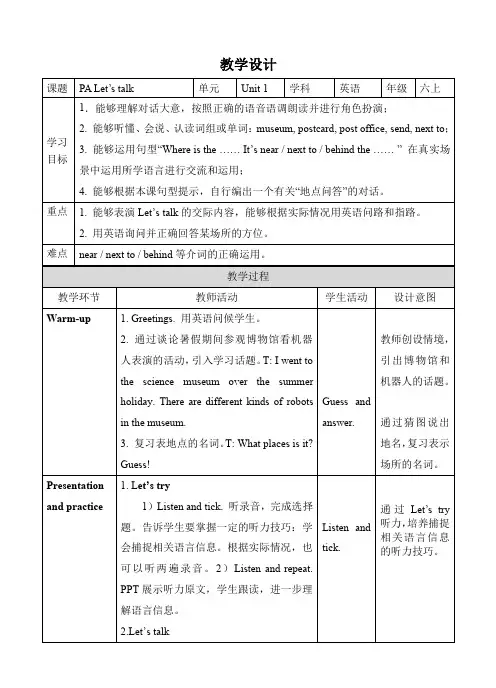
教学设计1)Lead-in.A.出示机器人和博物馆的图片,通过情景引导学生理解、学习句子What a great museum!B.创设对话情景,学习postcard和museum shop.C.创设对话情景,引出问题:2)Let’s watch.带着问题去看视频,熟悉文本内容。
然后回答问题,核对答案。
3)接着展示问题(任务),让学生思考、回答:①What places can you find?②Yifan wants to buy a_____and _____it today.③Who knows the post office?4)Listen and imitate.分句跟读,要求学生边听边模仿。
注意语音、语调和语气的模仿。
5)Fill in the blanks.完成补全对话空缺内容。
6)Role-play.三人一组开展分角色表演。
分层次提成任务要求。
Listen andread.Watch andanswer.Listen andimitate.小组活动,完成角色扮演对话。
通过创设会话情境,学习生词和难句,能够有效化解对话的难度。
通过回答问题、补全对话、分句跟读、角色朗读等不同活动理解和巩固语言知识。
Consolidation 1.Let’s enjoy.欣赏短片Where is Mr.Monkey?2.Brainstorming.归纳、总结表示方位的介词。
3.Ask and answer.两人之间运用句型A: Where is…?It’s…看图进行问答练习。
4.Pair work.Talk about the places in our city/town/village.此活动也可通过游戏的形式进行。
游戏规则:将预先准备好的邮局,学校,科学博物馆,商店,书店等的标牌放在教室里,把教室设计为一个社区,然后进行模拟情景的问答交流。
5.Summary.课堂小结,总结本课所学语言知识。
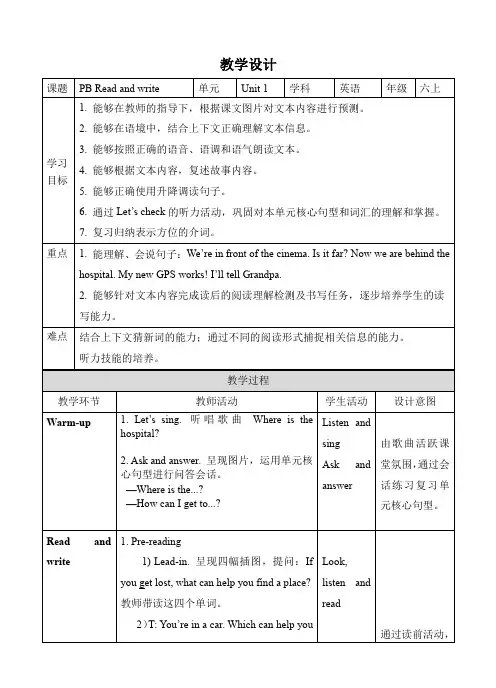
教学设计find a place?生回答:GPS.通过课件展示图文:Wu Yifan’s grandpa gave Robin a new feature.He nowhas GPS.He can help the boys find the Italian restaurant.学生能够听懂并理解意思。
3)引导学生看图,进行读前预测:How did they get to the restaurant?What places did they pass by?2.While-reading1)Read quickly and circle the places.2)Watch and answer the questions.学生听音跟读课文,完成9页的Answer the questions和Fill in the blanks。
3)Listen and repeat.课件展示课文,学生分句跟读,模仿正确的语音和语调。
4)要求学生分段大声朗读文本内容,可齐读、单独读,分角色朗读等多种练习形式。
3.Post-reading1)Draw and say.参考P2情景图,画出吴一凡去餐馆的路线,并用英语进行描述。
2)Tips for pronunciation.播放视频,让学生注意辨别不同句子的声调。
然后做出归纳。
1.Listen and tick the places you hear,then W学生思考、讨论,给予主观预测。
Listen andimitate.Listen,look andsay激活知识储备,引出话题。
阅读中,通过快速阅读抓大意,细读完成读写题和分句跟读等不同活动完成阅读任务。
读后,能够结合线路图,学会组织语言进行描述。
Let’s checkLet’s warp it up write the words under the pictures.教师播放录音前先让学生看图,说出看到的场所。
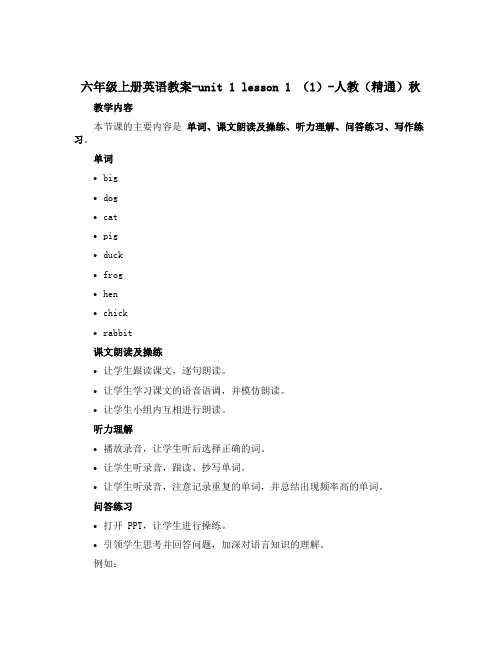
六年级上册英语教案-unit 1 lesson 1 (1)-人教(精通)秋教学内容本节课的主要内容是单词、课文朗读及操练、听力理解、问答练习、写作练习。
单词•big•dog•cat•pig•duck•frog•hen•chick•rabbit课文朗读及操练•让学生跟读课文,逐句朗读。
•让学生学习课文的语音语调,并模仿朗读。
•让学生小组内互相进行朗读。
听力理解•播放录音,让学生听后选择正确的词。
•让学生听录音,跟读、抄写单词。
•让学生听录音,注意记录重复的单词,并总结出现频率高的单词。
问答练习•打开 PPT,让学生进行操练。
•引领学生思考并回答问题,加深对语言知识的理解。
例如:Q: What’s this?A: It’s a rabbit.Q: What’s that?A: It’s a frog.写作练习在板书上呈现图片,让学生用单词进行描述,并将描述写在黑板上。
例如:•图片上是一只大猪。
•图片上有两只小鸡。
教学目标1.学生能正确听、说、读、写 lesson 1 的单词。
2.学生能流畅地朗读 lesson 1 的课文,并理解其中的语音、语调。
3.学生能听懂 lesson 1 的录音,并选择正确的单词。
4.学生能听懂问题,并用所学单词进行回答。
5.学生能用英语描述图片中的内容。
教学重难点•教学重点:课文朗读及操练、听力理解、问答练习、写作练习。
•教学难点:课文朗读及操练、听力理解、问答练习。
教学准备•教学 PPT。
•学生课本。
•录音笔及录音资料。
教学步骤1. 导入新课通过学生自然科学的知识引入本节课内容,激发学生学习英语的兴趣。
2. 学生自主学习让学生先进行自主学习,听录音、看课本、认真朗读课文。
3. 小组练习让学生分成小组,相互进行单词朗读及问答练习。
4. 教师指导操练通过 PPT 演示课文,引导学生进行语音语调的学习。
5. 练习总结进行总体练习,让学生复习所学内容。
6. 作业布置布置课后的习题作业。
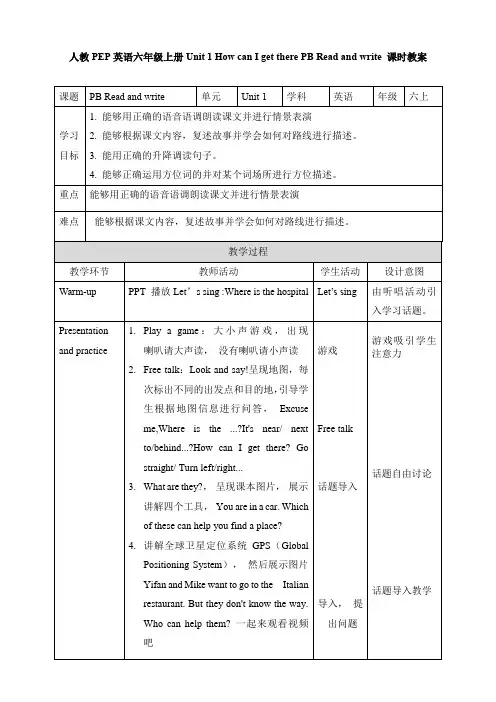
人教PEP英语六年级上册Unit 1 How can I get there PB Read and write 课时教案
5.播放read部分课文动画,理解课文大
意
6.呈现课文第一段,听音频,跟读,重
点词汇讲解,feature,help sb do sth,
并解决第一个问题 1.What is Robin's new feature?
7.呈现对话部分四图和文本,快速阅读对
话,找出第二个问题:How many places did they pass by?圈出地点单词,8.分解呈现四幅图和课文文本,听音频,
跟读,重点词汇讲解,并解决想对应
的问题,
9.Try to draw the road map according to the
text. 先画出线路图,然后根据线路图
补全文本,
10.Fill in the blanks, then retell the story.
11.Listen and fill:挖空,听音频对重要知
识点进行补充,加强记忆。
12.再次播放talk部分动画,观看后小组
进行对话练习,然后进行情景表演
1. 3人一组合作朗读。
2. 分角色表演对话。
3.情景展示表演
13.Listen and say,播放tips for
pronunciation部分辅助动画,引导学
生根据句子,总结出英语句子的语调
陈述句降调。
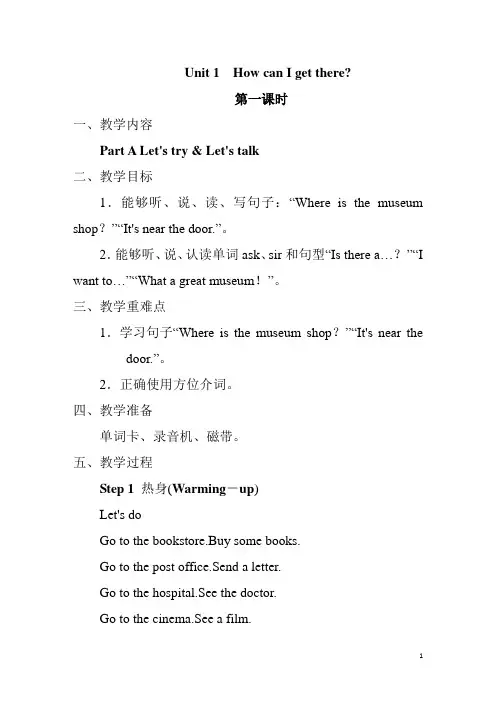
Unit 1How can I get there?第一课时一、教学内容Part A Let's try & Let's talk二、教学目标1.能够听、说、读、写句子:“Where is the museum shop?”“It's near the door.”。
2.能够听、说、认读单词ask、sir和句型“Is there a…?”“I want to…”“What a great museum!”。
三、教学重难点1.学习句子“Where is the museum shop?”“It's near the door.”。
2.正确使用方位介词。
四、教学准备单词卡、录音机、磁带。
五、教学过程Step 1 热身(Warming-up)Let's doGo to the bookstore.Buy some books.Go to the post office.Send a letter.Go to the hospital.See the doctor.Go to the cinema.See a film.Go to the museum.See some robots.Step 2 新课呈现(Presentation)1.学习Let's try(1)打开课本读一读Let's try中呈现的问题和选项。
(2)播放录音,让学生听完后勾出正确的选项。
(3)全班核对答案。
2.学习Let's talk(1)播放Let's talk的录音,学生带着问题听录音:Where is the museum shop?Where is the post office?听完录音后让学生回答这两个问题,教师板书:It's near the door.It's next to the museum.教师讲解:near表示“在附近”,next to表示“与……相邻”,它的范围比near小。
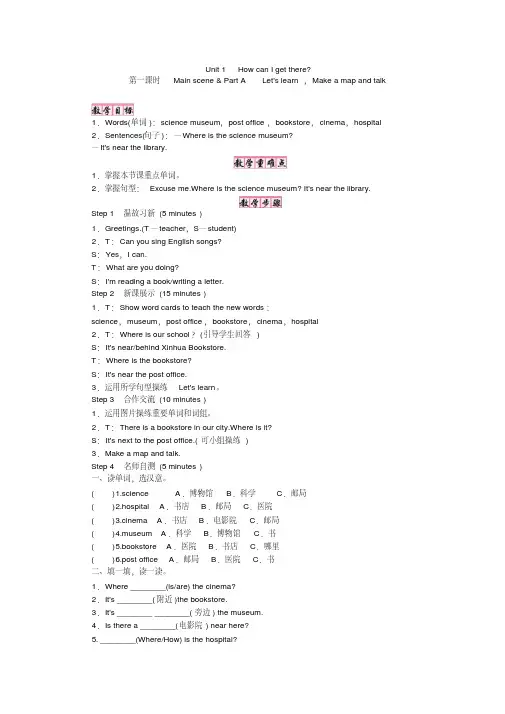
Unit 1How can I get there?第一课时Main scene & Part A Let's learn,Make a map and talk1.Words(单词):science museum,post office,bookstore,cinema,hospital 2.Sentences(句子):—Where is the science museum?—It's near the library.1.掌握本节课重点单词。
2.掌握句型:Excuse me.Where is the science museum? It's near the library.Step 1温故习新(5 minutes)1.Greetings.(T—teacher,S—student)2.T:Can you sing English songs?S:Yes,I can.T:What are you doing?S:I'm reading a book/writing a letter.Step 2新课展示(15 minutes)1.T:Show word cards to teach the new words:science,museum,post office,bookstore,cinema,hospital2.T:Where is our school?(引导学生回答)S:It's near/behind Xinhua Bookstore.T:Where is the bookstore?S:It's near the post office.3.运用所学句型操练Let's learn。
Step 3合作交流(10 minutes)1.运用图片操练重要单词和词组。
2.T:There is a bookstore in our city.Where is it?S:It's next to the post office.(可小组操练)3.Make a map and talk.Step 4名师自测(5 minutes)一、读单词,选汉意。
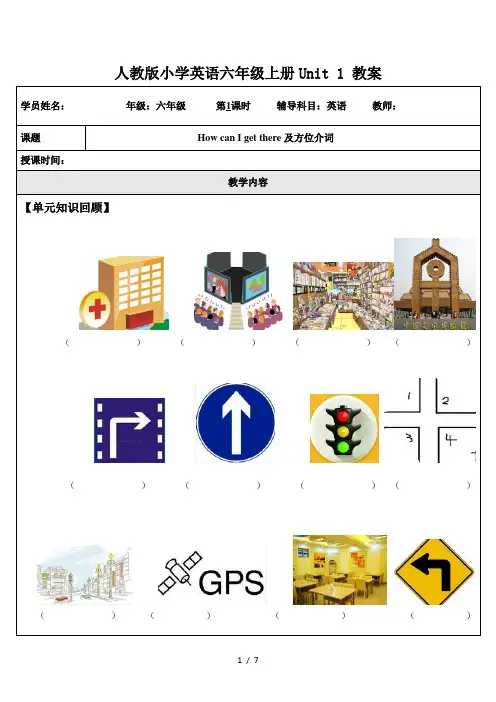
人教版小学英语六年级上册Unit 1 教案学员姓名:年级:六年级第1课时辅导科目:英语教师:课题How can I get there 及方位介词授课时间:教学内容【单元知识回顾】()()()()()()()()()()()()()()()重点单词和句型的讲解:◆Where 引导的特殊疑问句;是用来对地点进行询问。
基本结构为:Where + is/ are +主语?回答:It is / They are +介词+地点。
Eg : ---Where is your school? 你的学校在哪里?----It’s near the bookstore. 在书店的附近。
练一练:学生们在哪儿?他们在教室里。
◆表示感谢的“谢谢”1. Thanks a lot 非常感谢Many thanks 多谢Thank you very much. 非常感谢。
Thank you all the same. 仍然感谢你。
Tips:当别人向我们表达感谢时;我们可以说: You’◆ want to do sth 想要做某事Eg : I want to open the window. 我想要开窗。
表示想要;还可以用“would like”;常用句型为:Would you like….?练一练:我想要一本漫画书。
你想要一些果汁还是咖啡?◆Excuse me.常用作与陌生人开始谈话或者是打扰别人时的礼貌用语;常见用法如下:引起别人的注意;如问路或者询问姓名Excuse me ;is there a hospital near here?请求许可Excuse me. May I use your pen ?打断别人的讲话Excuse me. I must go now.Eg: . Where is the bookstore; please?; I don’t know.A . Excuse me B. Sorry◆喜欢“like”的用法◆常见的指路用语Go straight and …. turn right +at the ….. turn left +at the ….直走;然后。

人教版小学英语六年级上册《Unit 1 How can I get there 》单元说课稿(6课时)说课稿一. 教材分析《Unit 1 How can I get there》是人教版小学英语六年级上册的第一个单元,本单元主要围绕“如何到达某个地方”的主题展开。
通过本单元的学习,学生能够掌握有关交通工具和方向的词汇,如bus, trn, car, left, right, strght等,并能够运用这些词汇描述自己的路线和询问他人的路线。
同时,学生还能够学会使用can引导的一般疑问句,询问他人能否做某事。
本单元的内容与学生的生活实际紧密相连,有利于激发学生的学习兴趣和积极性。
二. 学情分析六年级的学生已经具备了一定的英语基础,能够听懂并运用简单的英语进行交流。
然而,部分学生在英语学习上存在一定的困难,如词汇量不足、语法知识不扎实等。
此外,学生在学习过程中容易受到母语的干扰,导致英语表达不准确。
针对这些情况,教师在教学过程中应注重激发学生的学习兴趣,调动他们的积极性,同时加强对学生英语基础知识的巩固和指导。
三. 说教学目标1.知识目标:学生能够掌握有关交通工具和方向的词汇,如bus, trn,car, left, right, strght等;能够运用这些词汇描述自己的路线和询问他人的路线;学会使用can引导的一般疑问句,询问他人能否做某事。
2.能力目标:学生能够在图片或情景的帮助下,正确使用本单元所学词汇和句型进行简单的交流,达到“能交流”的目标。
3.情感目标:培养学生热爱生活、积极乐观的人生态度,使他们更加关注身边的事物,学会用英语描述生活中的场景。
四. 说教学重难点1.重点:学生能够掌握有关交通工具和方向的词汇,如bus, trn, car,left, right, strght等;能够运用这些词汇描述自己的路线和询问他人的路线;学会使用can引导的一般疑问句,询问他人能否做某事。
2.难点:学生能够在实际情景中灵活运用本单元所学词汇和句型进行交流,同时注意语音、语调的准确表达。
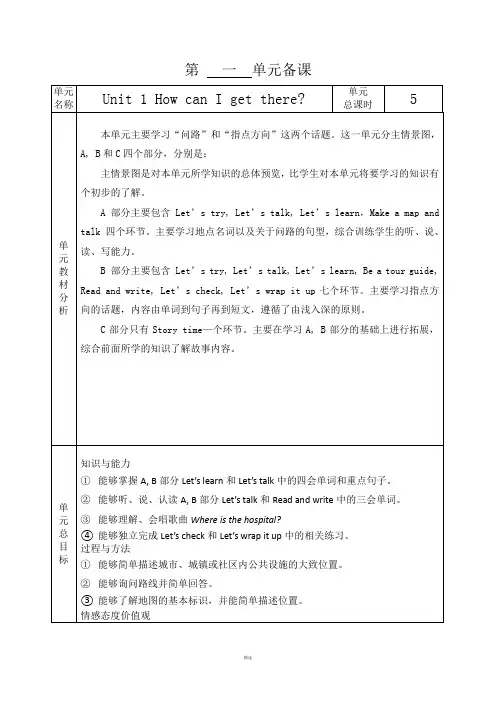
2. 课本个性化书写活动(1) Discuss with your partner. What are you going to do for Mid-autumn Festival?➢先让学生同桌口头交流。
➢教师将最后一位学生的回答在投影仪下示范书写,然后提出一星和两星要求,请学生个性化书写。
Step five: homework课后作业Write down your plan.For Mid-Autumn Festival, I’m going to ___________ ___________________. My partner is going to _________________________ ___________________.板书设计反思重建第 3 单元第 6 课时备课课题Unit 3--6课时安排1教学目标1.复习一般将来时态的三个核心问句以及回答:What are you going to do? When are you going? Where are you going?2.巩固一般将来时的句法要点,能够用不同的主语进行be going to的造句以及自由表达。
3.能理解、听懂并讲Story time中的故事。
学生能够用正确语音语调朗读语篇,并能够知道日记的格式。
培养自主学习能力重点难点重点:一般将来时的语法要点复习。
难点:能在实际情景中灵活运用以及正确的回答课前准备教师自制课件。
词卡,录音机,磁带基本环节集体资源个人增减教学过程Step One: warming up1. Free talks: What are you going to do? When are you going?Where are you going?Step Two: Wrap it up1.教师将提到的三个问题写到黑板上,并询问一般将来时的特点。
(1)be going toPractice: I _____ going to…He ____ going to see a film.They ____going to watch TV.(2)时间状语:this morning this afternoon this evening tonight tomorrow next week2. How many sentences can you make?(1) Talk about it in pairs.(2) Feedback.Step Three: Story Time1. Watch the video and answer the questions:2. Watch it again and learn some new words授课时间:。
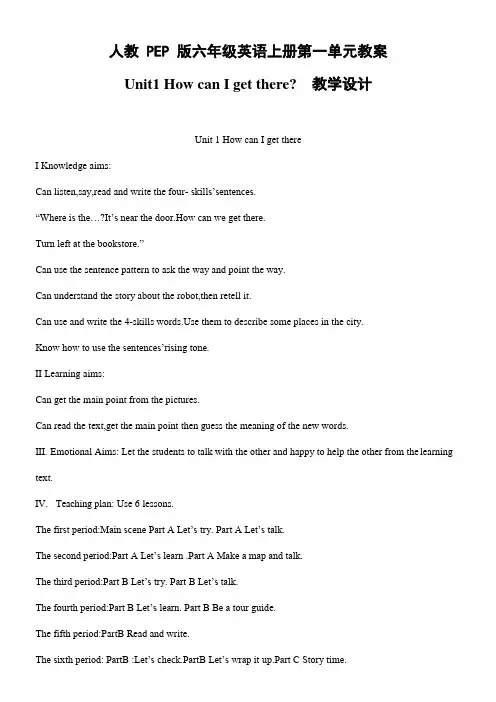
人教 PEP 版六年级英语上册第一单元教案Unit1 How can I get there? 教学设计Unit 1 How can I get thereI Knowledge aims:Can listen,say,read and write the four- skills’sentences.“Where is the…?It’s near the door.How can we get there.Turn left at the bookstore.”Can use the sentence pattern to ask the way and point the way.Can understand the story about the robot,then retell it.Can use and write the 4-skills e them to describe some places in the city.Know how to use the sentences’rising tone.II Learning aims:Can get the main point from the pictures.Can read the text,get the main point then guess the meaning of the new words.III.Emotional Aims: Let the students to talk with the other and happy to help the other from the learning text.IV.Teaching plan: Use 6 lessons.The first period:Main scene Part A Let’s try. Part A Let’s talk.The second period:Part A Let’s learn .Part A Make a map and talk.The third period:Part B Let’s try. Part B Let’s talk.The fourth period:Part B Let’s learn. Part B Be a tour guid e.The fifth period:PartB Read and write.The sixth period: PartB :Let’s check.PartB Let’s wrap it up.Part C Story time.Unit1 The First PeriodTeaching contents:Main scence,Part A Let’s try &Let’s talk.Teaching aims:1.Can read and use the sentences “Where is the science museum?It’s…. How can I get there?”exactly.2.Can listen,say ,read and write the words of the places.Then use them to ask the way or point the way. III.Teaching key points:Can use the sentences from the dialogue to ask the way in the real life.I V.Teaching difficulties:Use English to ask the way and point the corretposition way.V.Teaching aids:Multimedia ,map and the PPT.VI:.Teaching procedure:Step1 Warming upLet’s look and say the names.(the name of some places.)Let’s listen and chant.As:Museum ,museum,where is the museum?Bookstore,bookstore,Whereis the bookstore?Let’s go,go,go Hospital,hospital,where is the hospital?Step 2PresentationMain scenc.A.Look at the picture from the PPT of the main scenc.Talk with the students.B.Read after the tape.Learn”Let’s try.&Let’s talk.”Let’s play a game.Act out the dialogue.Act the dialogue by group.3.Make a survey.Talk in group then finish the survey.Step3 ConsolidationMake a real place ,let the student to ask the way and point the way.Step4 HomeworkListen and recite the dialogue.Finish the relevant workbook exercises.Make a new dialogue according to this lesson and act it out.Step5Bb writingUnit1 How can I get there?Where is the bookstore/post office…?-It’s over there./near….The Second PeriodI.T eaching content: A Let’s learn .Part A Make a map and talk.II.Teaching aim:A.Can understand and use the sentences “There is…Where is the cinema?It’s next to the bookstore.”to ask and point the way.B.Can listen,say and read the words of the places.C.Can use the words of position exactly.III.Teaching key points:The students can use the sentences parten to ask and point the way in the real life. IV.Teaching difficulties:Can use the words of position correctly to point the way.V.Teaching aids:recorder,tape,picture and PPT.VI.Teaching procedures:Step1 Warming up1.S ing a song”Where is the hospital?”2.L ook at the pictures and say the names.As(zoo,cinema,bookstore…)Step2Presentation1.Let’s learn.Show out of the picture,then talk with the students,draw out of the words of places.2.Learn the new words by talking.3.Listen and fill in the blank.Listen “Let’s learn,”then blank the answer.Step 3 Practises1.M ake a map and talk.2.G roup work.make a map of your home,then make a dialogue in group.3.Make a survery.Step 4 Consolidation1.Play a game.Ask and point the way2.Finish the exercises in the workbook.Step 5 Homework1.Listen and repeat the dialogue.2.Make a new dialogue and act it out.Step6 Bb writingUnit 1How can I get there?The Second PeriodThere is a park in my city.Where is it?It’s near +(bookstore+park+ science museum+hospital+cinema)The Third PeriodITeaching content:Part B Let’s learn.Be a tour guide.II Teaching aims: 1.To learn the new words : crossing , turn left , go straight , turn right2.To learn the key sentences: How do you go there? I go by ...3.Student can make sentences use the key sentences.4.To learn the “ let’s talk ’’IIITeaching key point: The key sentences: Where is the Italian restaurant?Turn right here? No, turn left.IV Teaching difficult:1. Make sentences use the key sentences.2. Translate into Chinese : “ Let’s talk ”V Teaching aids :The word cards, a tape , the model of road.VI Teaching prucedures:anization 1 , Greetings :sing a song 2 , Free talk2.Revision1, Review the words2, Review the rules and pronunciation of the tense 3.Presentation1, Open the book “ let ’s learn ”2, Teacher show cards of the new words :crossing , turn left , go straight , turn right 3, Listen to me carefully4 , Read after me5 , Listen to the tape and read after it6 , Learn the key sentences :Where is the Italian restaurant?Turn right here?No, turn left.7 , Translate into Chinese and teacher explain8 , Read after meIV Practice1, Read new words by themselves2, Listen to the tape and read after it3 , Give enough time to read them4 , Let students make sentences5. Summary and homework1 , Read and write down the new words2 , Recite the key sentencesThe fourth periodITeaching contents:Part B Let’s try.&Let’s talk.II.Teaching aims:Can use the sentences in the real life exactly.Can use the words and sentences parton to talk.III.Teaching key point:Can use “Where is the…?&How can I get to…? to ask and point the way.”IV.T eaching difficult:Can use”How can I get there?Turn left,Turn right.”exactly.V.Teaching aid:I Organization1 , Make a map and talk2 , Free talkII Revision1 , Review the new words : crossing , turn left , go straight , turn right2 , Review the key sentencesIII Presentation1 , Open your book .2 , Today , We’re going to learn the “ let’s talk ”3 , This is the dialogue of Wu, Mike and Robin4 , Let’s translate into Chinese : Teacher say English6 , Read after me7 , Listen to the tape and read after itIV Practice1 , Read “ Let’s talk ” by themselves2 , Listen to the tape and read after it3 , Answer the questions and write down the books.V Summary and homework1 , Read and write down the “ Let’s talk ”2 , Recite the “ Let’s talkThe Fifth PeriodI.T eaching contents:Part B Read and write.II.Teaching aim:Can use the words of orientation exactly.Can use English to solve some questions.III.Teaching key points:Can retell the text of “Robin has GPS!”Can write the words as:map ,compass…IV.T eaching difficult:Can use English to ask and answer the orientation of some places. V.Teaching aids: Multimedia ,map and the PPT.VI.Teaching procdures:I Organization1 , Free talk : the key sentences2 , Let’s tryII Revision1 , Review the “Let’s talk ”2 , Let’s readIII Let’s check1 , Listen and tick the places you hear2 , Write the words under the pictures3 , Listen again and answerIV Let’s wrap it up Try to write more words V Practice1 , Recite the “ Let’s talk ”2 , Read “ Let’s talk ” by themselves3 , Listen to the tape and read after it4 , Give enough time to read themVI Summary and homework1 , Finish the English excise2 , Recite the “ Let’s talk ”3 , Read and write down the new wordsBb writing:Where is the…?It’s….map/compass/GPS/stars/feature/far/tell/gave/follow.The Sixth PeriodI.Teaching contents:Part B Let’s check.&Let’s wrap it up.PartC story .II.Teaching aim:Can understand the story,can use the sentences to ask and point the way.III.Teaching key points:Depand the story to consolidate the way to ask and point the way.I V.Teaching difficult:Pass the story,Know how to use the sentences learn by this unit to ask and point theway in the real life.V.Teaching aids:computer and PPT.VI.Teaching procedures:Step1 Warming up1.L et’s sing a song.”Where is the hospital?2.Play a game”Where is baba?”Step2 Presetation3.Look at the PPT.Through the flash of the story,to practice the sentences in this unit.4.Ask some question depand on the story.As:Where is the London Eye?Where is the Thames?Where is the “Fish & Chips”shop?5.A ct out the story in group.6.A sk some group to act it out.Have a race.Who is the winner?Step3 Consolidation7.L et’s check.A.Listen and tick the places you hear.Write the words under the pictures.B.Listen again andanswer the questions.8.L et’s wrap it up.Step4Homework1.Listen and repeat the Fun story.2.Finish the exercises in the workbook.3.Make a new dialogue and act it out.Bb writing:Where is the …?It’s over there/near…。
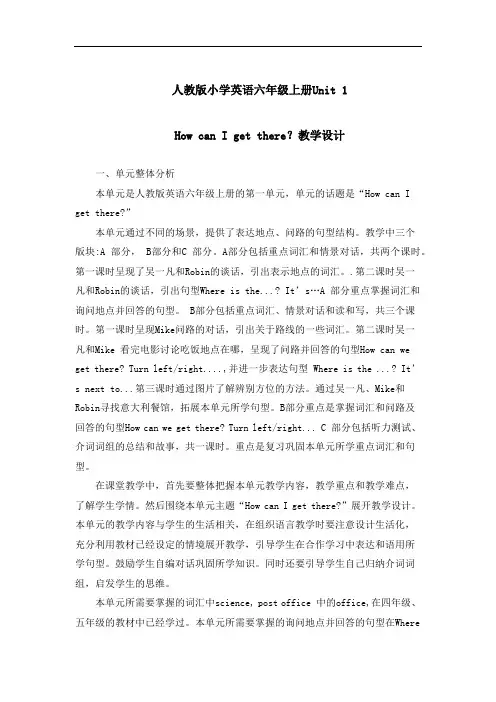
人教版小学英语六年级上册Unit 1How can I get there?教学设计一、单元整体分析本单元是人教版英语六年级上册的第一单元,单元的话题是“How can I get there?”本单元通过不同的场景,提供了表达地点、问路的句型结构。
教学中三个版块:A 部分, B部分和C 部分。
A部分包括重点词汇和情景对话,共两个课时。
第一课时呈现了吴一凡和Robin的谈话,引出表示地点的词汇。
.第二课时吴一凡和Robin的谈话,引出句型Where is the...? It’s…A 部分重点掌握词汇和询问地点并回答的句型。
B部分包括重点词汇、情景对话和读和写,共三个课时。
第一课时呈现Mike问路的对话,引出关于路线的一些词汇。
第二课时吴一凡和Mike 看完电影讨论吃饭地点在哪,呈现了问路并回答的句型How can we get there? Turn left/right....,并进一步表达句型 Where is the ...? It’s next to...第三课时通过图片了解辨别方位的方法。
通过吴一凡、Mike和Robin寻找意大利餐馆,拓展本单元所学句型。
B部分重点是掌握词汇和问路及回答的句型How can we get there? Turn left/right... C 部分包括听力测试、介词词组的总结和故事,共一课时。
重点是复习巩固本单元所学重点词汇和句型。
在课堂教学中,首先要整体把握本单元教学内容,教学重点和教学难点,了解学生学情。
然后围绕本单元主题“How can I get there?”展开教学设计。
本单元的教学内容与学生的生活相关,在组织语言教学时要注意设计生活化,充分利用教材已经设定的情境展开教学,引导学生在合作学习中表达和语用所学句型。
鼓励学生自编对话巩固所学知识。
同时还要引导学生自己归纳介词词组,启发学生的思维。
本单元所需要掌握的词汇中science, post office 中的office,在四年级、五年级的教材中已经学过。
人教 PEP 版六年级英语上册第一单元教案Unit1 How can I get there? 教学设计单元课程纲要词汇课(Part A、B)课程标准相关的陈述:能借助录音、图像、手势听懂简单的话语或录音材料;能听懂课堂活动中简单的提问;能在口头表达中做到发音清楚,语调基本达意;能认读所学词语;能根据拼读的规律,读出简单的单词;能读懂教材中简短的要求或指令;能正确地使用大写小字母和常用的标点符号;能根据图片、词语或例句的提示,写出简短的语句;学习目标:Part A:1.我能够借助拼读规则、图片,听、说、读、写四会单词:post office, hospital, cinema, bookstore, science museum 并能在情景中正确运用。
达成率 100%。
(重点)2.我能设计真实的情景运用句型。
Where is the … ? It’s next to/near the …。
(难点)Part B:1.我能够借助拼读规则、图片、听、说、读、写四会单词:,crossing, turn left, go straight, turn right.并能在情景中正确运用。
达成率 100%。
(重点)2.我能设计真实的情景运用句型。
How can we get there? Turn left at the bookstore.(难点)评价任务 1.激励性评价:口语评价good,super,you’re clever...2.过程性评价:倾听、英语角、复习、合作、展示、检测学习活动:目标 1:利用拼读规则看图认读新单词。
游戏(What’s in my hand?)目标 2:Make a survey and fill in the form.Show time结果纸笔测试:1.Listen and choose.2.Write down a sentence according to the pictures.对话课(Part A、B)课程标准相关的陈述能听懂课堂活动中简单的提问。
人教PEP 版六年级英语上册第一单元教案Unit1 How can I get there? 教学设计第一课时教学内容:A Let’s try Let’s talk C Let’s wrap it up教学目标:1.帮助学生理解对话,并学会运用句型“Where is the ...? ”问路。
2.帮助学生学会运用词组“near,next to, behind”等表述方位。
达到简单的交际。
教学重难点:重点:1. 句型:Where is the ...? It’s near/next to/behind ....2. 运用句型问路,表述方位。
难点:运用句型问路,表述方位。
教学准备:课件教学过程:1.Warm -- up师生自由问答:T: Hello, nice to meet you!Ss: Nice to meet you!T: What's the weather like today?Ss: It's sunny!T:Good!What's this in English?Ss:A book.T:Yes,It's my book.Where can we buy the book?Ss: The bookstore.2.Presentation and practice(精讲点拨)(1)在黑板上画一座房子和一个机器人,指着机器人说:Who’s that? 学生回答:It’s Robin. 再指着房子说:Where can we find Robin? 学生回答:In the museum. 出示感叹句:What a great museum!出示一张明信片,说:"It’s a post card.Robin wants to send a post card.Where should he go?”引出单词 post o ffice.出示一张地图,问学生:“Where is the post office?”出示单词:next to, near, behind.利用三个例句结合图片理解 next to, near, behind.(4)在学生理解三个方位介词后,小组活动,利用方位介词描述途中各个场馆的位置。
1.Enjoy some pictures of London学生边听边欣赏伦敦图片,认识并说一说对伦敦印象。
T: Zoom and Zip are searching some interesting pictures on line. What are these pictures about?Ss enjoy the pictures and answer : London.T: How do you know? What do you see in the pictures?S s: I see…T: London is the capital city of the UK.Do you like London?What do you think of London?S s: I think London is …. Because…1.Let’s chant.T: Zoom and Zip want to travel to London. But they need to go to the airport first. Do they know how to get to the airport?Ss: No.T: We can use GPS to help them.Ss chant.①Ss listen and chant.学生听GPS语音指令,跟老师一起边做动作边chant前两个路口。
②Ss make a new chant 学生观看GPS指引,按节奏和同桌进行编创chant.Ss look and then make a new chant with desk mates.③Ss think and guessT: There are some other ways to the airport. Why do they choose this way to the airport?Ss observe and then guess: Maybe he is a foodie. / Maybe he likes Chinese food…T: Hooray! Finally, they arrive in the airport. They’re going to fly to have a nice trip.T oday’s story is about Zoom and Zip’s trip in London. Let’s go and have a look!(贴课题板书)PresentationT: They meet a boy in the park. Look at Zoom and the boy. What’s happening between them? S s: Zoom is hungry. He wants to eat the food in the boy’s hand.T: What’s that food?Ss guess.T: Fish and chips. Does he eat the food at last? How does he get the food at last?Ss guess.2.Watch and answerSs watch and answer: He buys fish and chips in a shop. (贴板书)3.Think and guessT: Does he know the way to the fish and chip shop?Ss: No.T: He asks some people for help. How many people does he ask?Ss: Three.T: If you were Zoom, how would you ask ?Ss think and guess: How can I get to…/ Where is…4.Read quickly and findSs read and find out what Zoom say. 学生读前五幅图片,快速浏览找答案。
六年级上册英语教学设计-unit 1 lesson 1 (1) -人教(精通)秋一. 教学目标1.能够口头表达自己叫什么名字以及询问别人的名字。
2.能够辨认并正确使用单词“name”和“what’s”。
3.能够听懂并理解日常用语。
二. 教学重点1.学习自我介绍以及询问别人的姓名。
2.掌握并正确使用单词“name”和“what’s”。
3.提高听力理解水平。
三. 教学难点1.在实践中正确使用本课所学内容进行口语交流。
四. 教学内容1. 导入(5分钟)教师介绍自己的名字,并鼓励学生介绍自己的名字。
引入本课的主要内容:Learn English, Unit 1, Lesson 1, Part 1.2. 学习(10分钟)在板书上写下“What’s your name? My name is…”,解释意思。
教师用手势示范如何问别人姓名以及回答自己的姓名。
然后进行集体练习,教师问学生“What’s your name?”,学生以My name is … 回答。
再一遍学生依次回答,让每个学生都有机会练习回答。
3. 提高练习(15分钟)教师让学生找个同桌进行练习,彼此交流姓名并进行模拟对话。
教师会在过程中给予指导并纠正其发音问题,让学生发音清晰,语音流利。
让学生更好的理解句子。
4. 集体模拟(10分钟)教师让两组同学来进行模拟对话,展示出已经掌握了正确的对话方式和技巧。
5. 悬挂词汇(5分钟)教师将“What’s”和“name”两个单词挂在黑板上,让学生辩认并朗诵。
6. 听力练习(10分钟)教师朗读一些日常用语,然后让学生跟读并理解。
听力练习的目的是让学生提高听懂英语的能力。
五. 课堂练习一、选择正确单词来回答问题:1.__ name is Tom.A. IB. YourC. My2.—- What’s your name?—- __ Jim.A. He’sB. I amC. My name’s二、别名游戏:学生两两配对,互相询问彼此名字。
教学设计幻灯片呈现十字路口的图示,单词和发音,学生跟读。
2)同样的方式学习turngo straight等。
2.Watch and learn.1)Listen and answer.教师先提出问题How can he get there?Turn left or turn right?然后播放Let’s learn中的对话部分,让学生根据理解回答正确答案。
2)Watch and follow.播放flash动画。
通过看、听、跟读多感官学习生词。
3.Practice1)音义匹配。
听发音快速说出汉语意思。
2)Look and say.看图说出对应的单词或短语。
3)Read and chant.Watch andlearn.Look andsay.Read andchant.通过观看视频、音义匹配、Letus chant等不同活动形式,充分体验、运用,以巩固所学词汇。
Consolidation 1.Be a tour guide1)呈现北京的三处名胜景点,学习英语的表达法。
2)T:Chen Jie is trying to be a tour guide(导游)for Oliver in Beijing.Can you help her?3)读图,补全空缺部分。
2.Summary.课堂小结,总结本课所学语言知识。
3.Exercise.Fill in the blanks.呈现图片和句子提示,补全空缺部分。
Think andanswer在模拟情境中运用词汇和句型。
由语言输入到语言输出。
Homework 1.听录音跟读Let’s learn中的单词、短语和对话,并规范抄写2遍。
2.设计一张从家到某一地点的路线简图,然后用英语写出如何到达目的地。
3.完成同步练习根据个人学力,分层完成任务。
设置不同层次作业。
板书。
第六课时B Let’s check& Let’s wrap it up一、教学目标与要求1.看图听录音,听后完成判断任务。
2.能够通过听力培养学生良好的听力习惯,提高学生的听力水平。
3、复习本单元的核心词汇,启发学生思维,让学生学会进行总结。
二、教学重、难点2.能够通过听力培养学生良好的听力习惯,提高学生的听力水平。
3、复习本单元的核心词汇,启发学生思维,让学生学会进行总结。
三、教学准备:多媒体课件。
单词图片四、教学步骤和建议Step1.Preparation歌曲导入。
Where is the hospital ?Step 2.Presentation&Step3 .Practice1、Listen and tick the places you hear .Write the words under the picture.1)教师请学生看图,说出所看到的场所,对可能要听到的单词做到有心理准备。
然后教师播放录音。
2)教师通过提问,检测学生是否听懂并能找出正确答案。
3)教师校对答案,请学生在没有选中的图片下写出对应的单词或词组。
2、Listen again and answer.1)教师带领学生读第一题:Where does the boy want to go ? 请学生回忆这里应该用什么单词回答提问,并鼓励学生说出完整句子。
2)教师先请学生看教材中的图片,口头描述如何从学校到邮局,然后听录音回答第二个问题。
3)师生共同核对答案。
Step4.ProductionLet’s wrap it up1、教师组织学生看图,并口头造句。
2、学生完成所有的填空,再鼓励学生学生自己增加更多的方位词,如:north , south, west ,near 等,达到词汇复习和归类的目的。
Step5.Progress1、做配套相应的练习。
2、Summary:what have you learned today ?3、Homework :学生做自测。
人教版小学六年级英语上册Unit1 讲义
【单元知识回顾】
()()()()
()()()()
()()()()
()()()
重点单词和句型的讲解:
◆Where 引导的特殊疑问句,是用来对地点进行询问。
基本结构为:Where + is/ are +主语?回答:It is / They are +介词+地点。
Eg : ---Where is your school? 你的学校在哪里?
----It’s near the bookstore. 在书店的附近。
练一练:
学生们在哪儿?他们在教室里。
◆表示感谢的“谢谢”
1. Thanks a lot 非常感谢Many thanks 多谢Thank you very much. 非常感谢。
Thank you all the same. 仍然感谢你。
Tips:当别人向我们表达感谢时,我们可以说:You’re welcome. (不用谢)或者是My pleasure. (乐意效劳) ◆ want to do sth 想要做某事
Eg : I want to open the window. 我想要开窗。
表示想要,还可以用“would like”,常用句型为:Would you like….?
练一练:
我想要一本漫画书。
你想要一些果汁还是咖啡?
◆Excuse me.常用作与陌生人开始谈话或者是打扰别人时的礼貌用语,常见用法如下:
引起别人的注意,如问路或者询问姓名Excuse me ,is there a hospital near here?
请求许可Excuse me. May I use your pen ?
打断别人的讲话Excuse me. I must go now.
Eg: . Where is the bookstore, please?
, I don’t know.
A . Excuse me B. Sorry
◆喜欢“like”的用法
1. like +名词/代词意为“喜欢某物或者某人”
◆常见的指路用语
Go straight and …. turn right +at the ….. turn left +at the …. 直走,然后。
到。
处右转到。
左转
Eg : ---Excuse me. Where is the hotel please? 打扰了,你知道旅馆怎么去吗?
---Go straight and turn left at the hospital. Turn right at the bus stop and you can see .
直走,然后在医院处左转,到公车站之后再右转,你就可以看到了。
●常见的指路句型:
1. Go down /along this street / road. 沿着这条街/路往前走。
2. Turn left / right at the first crossing /turning. 到第一个十字路口左/右转。
3. Go on until you reach the end. 向前一直走到尽头。
4. Go/ Walk straight for +一段时间…. 直走….分钟(时间)
5. It’s on the corner of…. 在…的拐角处
练一练:
----打扰了,请问怎么去新华书店?
---- 沿着这条街直走,在第一个路口处向左转,然后你会看到一个篮球场。
然后直走5分钟,你就可以看到新华书店在你的前面。
4. 到书店处左转.
.
5. 打扰了,清晖园离这儿远吗?
. Is the Qing huiyuan here?
6.沿着这条街直走5分钟。
this 5 minutes.
7. 在第二个十字路口向右转。
at the .
四、按要求完成句子。
1. There is a cinema near here?(改为一般疑问句)
a cinema near here?
2. The hospital is near the post office.(就划线部分提问)
the hospital?
3. My home is next the park.(改为正确的句子)
.
4. Thank you very much.(请做出回答)
.
5.She likes playing the piano.(把句子变成否定句)
.
五、写作训练。
假设你是小米,你在这个星期天邀请你的好朋友天天到你家参加家庭聚会。
请根据给出的提示告诉天天去你家的方式。
提示:在我们学校前面的公车站搭371路公交车,在有邮局处下车,然后沿着街道直走5分钟,在第一个十字路口处向左转。
在你的右手边你会看到一家书店,我家就在书店的后面。